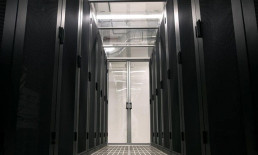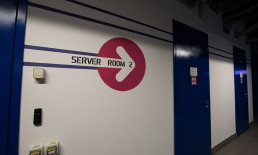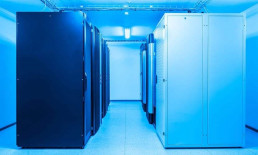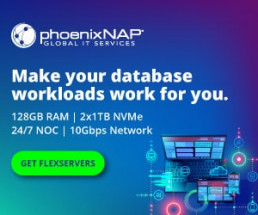What is a Dedicated Server? A Definition
You’ve noticed or had customer complaints that your application or website has been running slow. You have a reputable hosting provider, at least you thought you did, but you come to find out that you’re using shared hosting.
Apparently, there are other people within your server hogging all of the resources that you didn’t know you were sharing in the first place. Now your provider is recommending you buy a dedicated server to improve your site’s performance.
But what exactly is a dedicated server, and how does this compare with what you thought was working fine?

Dedicated Server Definition
A dedicated server is a computer set aside for a specific task, such as hosting a resource-intensive application or website. Dedicated servers can take several forms.
With a dedicated server, the server is a computer that is reserved explicitly on a network for your application or website.
For many web hosting companies, the standard type of hosting, or at least the lowest priced option, is in the form of cloud hosting. When your company chooses a public cloud provider, your application and website may reside on one or many computers and utilize cloud computing.
In a shared hosting solution, your website or app is vying for resources with an unknown number of other software applications. This creates a potential situation listed above where you start to experience slow-down or lag from someone else. These additional software applications and websites may use resources that your applications or site needs.
When speaking about dedicated servers with hosting companies, the service provider sets aside one server (or a single machine) to handle the workload the website or application requires. Managed servers give you access to your very own private cloud and give you the flexibility of cloud hosting but with your own resource center’s added security and speed.
In-House or Off-Site Servers?
In some cases, a dedicated server can be on-site at your place of business.
There are pluses and minuses to this type of solution.
The obvious benefit is that you have complete physical control of the hardware and who has access to it. This is extremely useful for companies that require the security of a closed computer network and a private cloud.
The security measures on these machines are often more stringent than those for companies that need website hosting. Companies that deal with financial data, medical records, or sensitive government regulated data are more likely to choose this option over companies that don’t require such measures.
The downside to having an in-house server is maintenance and scalability, especially if the machines are self-managed. Should you choose to go this route, you will regularly need to update your hardware and software, costing a company in time, resources, and money that could be utilized elsewhere. If you decide to outsource maintenance, there’s the problem of vetting technicians and ensuring that everything is completed to your satisfaction. You must also have a server room (or at least a place) that is appropriately climate and access controlled.
Backups and redundancy are something to consider with your own server.
If there is a problem with your data, if there is a catastrophic incident (hackers, disk failures, and natural catastrophes), or if there is a need for maintenance, you or your team are directly responsible for handling downtime. If your business requires that your servers be up and running 24/7, you will need to develop a plan to ensure that your applications or websites will still run when your primary server is down.
Off-site servers through a hosting company allow the application or web hosting company to provide a dedicated server but off-site, presumably at the hosting company’s data center. Companies most often rent these servers from hosting companies and have the hosting company handle the complexity of backups, redundancy, maintenance, and upgrades.

Dedicated Servers for Software As A Service (SaaS) Providers
Another business model that often utilizes dedicated servers is Software-as-a-Service (Saas), providers. By using the dedicated server as infrastructure to provide Software-as-a-Service products, companies can focus on their software rather than worry about infrastructure related concerns.
SaaS generally needs to be web accessible 24/7/365, so reliability is of vital importance. By leasing these types of servers from companies that are in the business of providing dedicated hardware, SaaS providers get a server that they can rely on. By allowing their provider to address any infrastructure related issues as they arise, they free up their technical staff’s valuable time to get back to doing what they do best—providing excellent software solutions for their customers. Many SaaS companies offer backups, support, and server management. Because dedicated servers can be rented rather than purchased outright, this option can provide an excellent way for small and medium-sized businesses to have the computing power of larger corporations.
SaaS providers often find it helpful to hybridize and use cloud resources as well. Administrators will often use the cloud to test out applications for software development and quality control before moving applications and websites over to dedicated servers.
Benefits to Dedicated Servers
There are many benefits to using dedicated servers.
The benefits include:
-
- Speed and agility. Your applications and websites have the advantage of being able to use all the resources on the server, without vying for resources with other applications.
- Security. You are less likely to have your programs and websites hacked because your sites and data reside outside of a public cloud and may be able to put into effect more security measure.
- Control. In some instances, a dedicated server (especially on site) allows more control over your hardware and software.
- Scalability. You can request more CPUs, more extensive networks, and more disk space if your applications require them. You can also upgrade to a faster and larger server that can handle the workload your websites and applications need.
- Customizable. Since you are renting or purchasing this server, you can have it set up any way you’d like.

Considerations with Dedicated Servers
When deciding on a dedicated hosting solution, you need to consider the following:
-
- Rent or Own Your Server? Depending on your needs, you may consider renting or owning a dedicated server. Renting gives you the ability to upgrade often seamlessly.
- Scalability. How many disks, processors, and network connections do you need up front and in the future? Knowing and understanding your needs will put you ahead when your business expands.
- On-Site or Off-Site? If you choose to keep the server in-house, you will have to have an appropriate place to house the server. It will need a climate controlled room with network connections. Who will administer the computers? Do you hire a third party to manage them or use someone in-house?

Should You Go With a Dedicated Server?
Dedicated servers, by nature, have actual hardware and software dedicated to a business’s application or website.
The question many business owners ask is if they should go with a dedicated server or if they should stay with cloud hosting? At first, many business owners opt for the cloud servers because of the attractive price. However, the choice becomes obvious when their applications and websites bog down due to heavy resource usage and high traffic. Often, they find themselves scrambling for better solutions when they should have chosen a dedicated server in the first place.
Businesses that have sensitive data or must comply with government regulations need to choose a dedicated server to decrease the potential risks to their data and possible loss of revenue and hefty fines. Any company that wants control over scalability and customization should consider using a dedicated business server over a cloud server.
In the long run, a dedicated server may prove to be advantageous to any business that works in E-commerce or requires agility on the web.
Recent Posts
Small Business Servers: Do You Really Need The Best Performance?
The server that you choose makes all the difference in your business efficiency. Depending on your decision, it could also thwart or aid in your ability to expand. Selecting the best server for your small business does not have to be a hassle. There are the standards that you can count on to make the right choice.
First, let’s go over the essential functions of a business server. Then, we will touch on the operating systems that drive servers and make them perform. These are two of the most critical aspects of choosing a server so that you can make an informed decision for your business.

Understanding The Functions Of A Small Business Server
Small to Medium Businesses need servers that scale to their needs. You should not overpay for resources that you do not use though this is a typical sales practice to bundle features into a solution. You should also have adequate hardware to deal with unexpected traffic spikes. Once a marketing program starts working, you will likely see improvements in your online traffic. You need a server that can handle these increases.
Here are the most common uses of a server in the small business environment:
-
- Securing hosting email. Startups can start by utilizing Gmail, Yahoo, or Mail.com, but it’s best to transition into a domain-specific email client quickly. SMBs should upgrade and think more deeply about security and their digital reputation.
- Hosting eCommerce. The right server provides secure and efficient commercial transactions. Your company must protect the personal and financial information of its clients. You may be held legally responsible for the unprotected information. Hosting eCommerce securely is essential.
- Hosting a website. You want your content to be available to your audience. Your web host determines the speed and efficiency of your site. Your web host can also make a tremendous difference in your search engine ranking.
- Hosting applications. Hosting apps on a remote server reduces your need for new hardware. Instead of purchasing equipment to store in-house, you can rent it through the cloud. Some common uses for internal apps include employee management, CRM, planning and invoice management SaaS apps.
- Creating a virtual server environment. Does your business cover multiple brands? You may need a virtual server interface. Do your employees work remotely? You may need virtual desktops. Your small business server hosting can make this happen.
- Data backup. You increase data storage security for your business when you back up to the cloud. If something unexpected happens, you can quickly reload a saved instance of your business. There is very little lag when this process is used efficiently. You may not even have to inform your customers that anything went wrong.
- Storing documents. Storing documents is essential for business continuity and data protection. It also aids in disaster and data recovery strategies. You can also enable employees to work remotely.
A remote server can deliver many other services to an SMB. Powerful small business servers can support all of these services at the same time and more. Many companies will use separate servers for each feature. This makes a company more accessible to expand digitally.
Your Operating System
The operating system is of vital importance. Imagine if your home PC ran on an OS that you couldn’t work with and ultimately did not like to use. You would be quickly finding a solution that worked and was much more effective. Think of the operating system in the same way.
Server software requires a specialized OS. It’s not often that you’ll see the same operating system on your desktop as in a server. There may be similarities, but ultimately the functionality will be different.
Here are your main choices when it comes to selecting the best server os for small business:
-
- Linux. This semi-popular desktop operating system is more often known as a server OS, made to work for many users simultaneously. Linux has many variations that combine a full OS and a package manager. You end up with a faster install and better operations this way. The most popular distributions for Linux includes Debian, CentOS, and Ubuntu.
- Windows OS. Microsoft names its OS after its desktop operating system, but rest assured that they are dramatically different when it comes to functionality. Microsoft Windows Server includes apps that support virtualization, security and the IIS web server.
Linux is more popular than Windows, server-side. Linux is free in many cases. It is also more efficient and less open to being hacked. Linux also can support many of the most popular open-source software options. Many Linux software packages are also free.
Windows offers a more pleasing graphical user interface (GUI) for server management. Linux requires learning complex command line syntax. Additionally, many business owners prefer to use Microsoft to complement their current base of applications. These applications often include Active Directory, MS SQL, and Sharepoint. These Microsoft branded programs run far more efficiently on their native platform.
Support is also a reason companies will lean towards Microsoft. They are known for years of helpful and responsive support. With Linux being open-source, your options for support are either researching yourself through online message boards or contacting your Linux distributor.

Dedicated vs. Cloud Servers
Once you’ve settled on an operating system, you need to decide on your server’s hardware infrastructure (to be fair, these choices would be made simultaneously). Your two main options are between a dedicated server versus a cloud-based server. They are both self-contained environments that are fully complete. However, the underlying hardware of each server type is used differently.
The Cloud For Small Business
Think of a cloud server as a piece of a dedicated server, in a way. From a customer perspective, you will receive similar benefits. However, you actually share the physical space with other clients. The thing is, you’ll never know that you’re sharing space or how many other people you’re sharing it with unless a major issue comes up.
The cloud is comprised of virtual machines. They run on top of an enterprise-grade dedicated server. The dedicated server can create multiple virtual servers and provide a virtual environment for each client.
Power
Each virtual server functions as a slice of a dedicated server. The virtual cloud server is always weaker than its bare metal base, but a virtual server can still be incredibly powerful.
Cloud servers can receive resources from many dedicated servers, creating a virtual space that can match the credibility of a dedicated environment. The total power available in the cloud depends on the physical servers providing resources.
Cloud servers have more than enough power to handle the needs of a small business. Multiple servers work together to manage various companies at the same time.
Resources
The Cloud can host websites, applications, file sharing applications, email clients and eCommerce. The primary functions are the same as a dedicated server though due to hardware differences, speed may suffer in a cloud environment.
There is a built-in latency that slows down all virtual servers regardless of their infrastructure. The extra layer of virtual processing between the base OS and outside requests for data requires more time regardless of the total resources that are available.
Efficiency
Even the best cloud provider will almost always lag behind even a moderate dedicated server. That said, it’s worth mentioning that most SMB’s do not require a dedicated server. Even if they do, they are so cost-prohibitive that it’s often more economical to weight the minimal differences in speed vs. performance as an overall hit on a business’s finances.
Cloud server hosting infrastructure is efficient enough to handle the needs of most small businesses and with minimal customer engagement. The company managing the server is just as important as the infrastructure. Make sure that you choose a reputable web hosting company with strong storage solutions.
Scalability
The virtual server is much easier to scale from the perspective of the client. Scalability, outside of cost, is the main advantage of the cloud over a dedicated server.
There must be available resources to allow a business to scale their server. The one disadvantage of the virtual space is that in a live environment, clients compete for resources. If many clients experience unexpected traffic spikes at once, the server may experience the “noisy neighbor” effect. There may not be enough resources to go around in this case and could cause a problem for multiple clients. Thankfully, this situation is often mitigated by a reputable host that is actively managing traffic across the network.
Scalability is also a perk for a growing business when they are looking to expand their entire environment. There is no need for downtime to add resources to the virtual space which becomes extremely attractive for companies. Adding cloud storage is an incredibly simple task. There are also many hosting companies that are investing strongly in machine learning architecture to better utilize resources.
Speed
The cloud can be slower than dedicated solutions because of the built-in lag. Speed in the world of virtual servers is a resource that can become volatile. If too many clients are vying for the same resources, the cloud slows down. Dedicated resources are always going to be faster, but with advancements in technology and a reliable hosting provider, these limitations are becoming less and less.
Cloud Server Pricing
Cloud servers are less expensive than dedicated business servers. There are many clients on a single piece of hardware. Each client only pays for a fraction of the resources on the physical server.
There are also fewer resources allocated to each client. In return, the price is much lower.

The Dedicated Server
The dedicated server is yours and yours alone, though it will most likely live inside of a data center. You don’t share it with another company, you don’t have to worry about another company hogging your resources, and you’re entirely responsible for it. Providers can service many clients simultaneously. When you rent a dedicated server, you are reserving your own dedicated space for your business. There are many advantages to this configuration though it’s not always ideal for every small business.
Power
Dedicated servers are the most powerful option for a server. The purpose of a dedicated server is to provide its client with more resources than it will ever need. Physical tower server hardware is difficult to upgrade without downtime. This results in large hardware racks for potentially limitless resources and efficiency but for a customer that may never utilize the power.
A dedicated server could potentially contain dozens of processors that can host hundreds of terabytes of data and thousands of users simultaneously. It’s likely to have many different storage options, large hard drives (configurable in hot-swappable compartments), aggressive graphics cards, and much more. You can also maintain the infrastructure of a complex eCommerce platform along with hundreds of concurrent applications.
Resources
Dedicated servers far outclass cloud servers concerning straight-up resources. However, dedicated servers are more difficult to upgrade. It is best to include all needed requirements within the original infrastructure build of the server. Dedicated servers are much less flexible than the cloud server in this regard.
Even a moderately featured dedicated server can support most SMB database and application trees.
Efficiency
A dedicated server is built to be highly effective for a single client. The client accesses the OS directly. No lag is generated from any additional layers of processing. The result is a very streamlined system. Dedicated servers are less stressed during peak traffic times. They are highly efficient for a more extended period when compared to cloud servers.
Scalability
A dedicated business server can be scaled through additional ports. Upgrading a dedicated box is much more difficult than scaling to the cloud. For that (and many other reasons), companies don’t often invest in a dedicated server as a short-term solution. Most businesses look for a server that can scale with them over time without drastic hardware changes.
Speed
The dedicated server is built to be fast. There are no extra layers of processing between the operating system and requests for data. There is no built-in latency. Additionally, data streams within the dedicated environment are genuinely isolated. All resources are allocated in one direction. There is never a risk of a loss of resources.
Price
Here’s the thing about dedicated servers: they are much more expensive than cloud-based options. As previously mentioned, dedicated server clients are paying for the use of all available hardware resources. Dedicated clients receive full use of these resources regardless of the outside environment. Resources can never be assigned away from the client.

Dedicated Server Options
The dedicated server has benefits over the cloud server regarding power, resources, efficiency, and speed. However, the virtual server is the more flexible and scalable option. Virtual servers are also much less expensive. Does your business need high-cost power or low-cost flexibility?
Dedicated servers often have more resources available than a small business requires. A small business may intend to scale in the near future and believe that a dedicated server is the way to go. Consider the following before committing.
The business world is a volatile one. Web traffic is not guaranteed. Just because a company experiences a spike in traffic one month does not mean that the traffic will last. You may not have the ability to accurately forecast future traffic. Companies may need more data before being able to commit to a dedicated server and stay out of the red.
Small businesses with a definite plan may need a dedicated server. This is especially true if an industry is expanding along with a company. If a company expects a consistent audience, then it may require a dedicated server.
In most cases, dedicated servers are reserved for enterprise-level companies. SMBs usually have less volume and therefore fewer requirements for space and power.
The flexibility and scalability of the cloud environment may be more important than the immediate power and the efficiency of the dedicated server. The elasticity of the virtual world matches the volatility of the business world.
Cloud servers can emulate a lower level dedicated server. However, resources allocated to a client in the virtual world can be taken away. Speed and efficiency can suffer for clients in the virtual world under certain circumstances. Both clients may experience a noisy neighbor effect. The effect can be temporary or sustained depending on the number of clients that are using the underlying physical server.

Servers For Small Business: Your Next Move
The average virtual server can handle the needs of most SMB’s. There are enough resources here to scale up without experiencing the noisy neighbor effect.
The dedicated server is much more expensive. Many small and medium-sized companies are on a strict budget. A growing company can benefit from a timely evolution into a dedicated server environment if they end up requiring it.
As a company, you want to do your research and understand the market before making a decision. Strive to create a cost-effective, long-term relationship with the right service provider. This partnership will allow your business to grow and prosper. Your industry is competitive and stressful. Make sure that your server solutions aren’t adding to that stress so that you can do what you do best: running your business!
Recent Posts
Data Center Tier Classification Levels Explained (Tier 1, 2, 3, 4)
Your choice between data center types is as important as your choice of a server regarding web hosting.
The right server in the wrong location means lousy performance. Fortunately, there is a system in place for your business to make the most informed decision.
You might think to yourself that all data centers must be alike, save for a few localized differences or independent security measures. You would be quite far from the truth in this assumption. Choosing a data center solution that is right for your business is much more straightforward once you understand the concept of “Tiers.”
Tiers, or levels, are ways to differentiate the requirements of each type of data center operator, with a focus on redundant components, critical load distribution paths, cooling, and many other specifications. As it stands now, there are four tiers, and as you would expect, they are defined precisely.
The Global Data Center Authority’s “Uptime Institute” is responsible for the proprietary “Tier Standard System.”
Uptime is the most critical metric when regarding web hosting, though not the only one. The rating system defines a benchmark for the data center industry.
Most experts agree that the standardized system has been well received. Here we take a look at the tiers from levels 1 through 4 (often displayed with Roman Numerals as I through IV). We will also discuss what to look for when examining data center power and infrastructure for your business.

What Are Data Center Tier Ratings?
The classification levels of data centers represent a certification of design. A tier is another way of saying “level of service.”
The 4 tiers of data centers are:
- Tier 1 Data Center
- Tier 2 Data Center
- Tier 3 Data Center
- Tier 4 Data Center
The Uptime Institute does not tell anyone exactly how it defines tiers, though the most important metrics are made public. These metrics include redundant electrical path for power, uptime guarantee, cooling capacity, and concurrent maintainability, to name a few.
Background of Data Center Tiers & Levels
The Telecommunications Industry Association (TIA) created the first set of standards for data centers in 2005.
The Uptime Institute standard was formed separately from the TIA standard. The Institute also differed from the TIA because of its specialty in data centers whereas TIA standards could apply to many different aspects of the IT industry.
The Uptime Institute last revised its certification process most recently in July of 2015.
It was discovered that there were data centers without official rankings that were stating the Institute certified them. Much of the controversy happened between the Tier III and Tier IV rankings.
Design elements still make a difference but are not as heavily weighted. Any classification that was based solely on design is now no longer listed on the Uptime Institute website.
The percentages for each metric remain a secret of the Institute.
The Uptime Institute Chief Operating Officer addressed “Efficient IT” in a press release. The release stated that day-to-day operations for a data center now count towards rankings.
The Institute has also created an “Efficient IT Stamp of Approval” for data centers that produce efficient outcomes.
There are two levels of Efficient IT certification:
-
- Approved Status – Data centers that achieve this status are already in compliance with previous Uptime Institute standards. The stamp of approval continues for two years. After the certification expires, the center must be re-evaluated to receive another two-year accreditation.
- Activated Status – Activation means that the Institute has observed a data center moving towards higher efficiency. The Activated status is only good for a year. If a data center has not achieved efficiency excellence, it may still be awarded Activated state upon a new evaluation.
Data Center Tiers 1, 2, 3, 4 Explained
A tier 1 data center can be little more than a powered warehouse. They are not required to be very sophisticated. On the other end of the spectrum is a tier 4 data center. This tier gives its clients a guarantee of uptime and 2N (two times the amount required for operation) cooling and redundant power and infrastructure. These standards will protect most companies. Level IV clients usually never even hear if there are issues at the data center infrastructures due to these redundancies. These standards show just how reliable top-tier systems are.
Tier 2 colocation data centers are more robust than Tier I centers. Tier II does not have complicated performance hardware. For instance, level III and IV data centers require dual power inputs. Level II does not. Level II gives clients a customizable balance between cost management and performance.
A tier 3 data center can perform repairs without any notable service disruption. Another way to define a level III provider is that they offer an N+1 (the amount required for operation plus a backup) availability for clients. As with any technology product, unplanned maintenance may still cause a problem in a level III provider. In short, level III is even tolerant of some faults.
Tier 4 data centers are considered “fault tolerant.” Unplanned maintenance does not stop the flow of data to a data center Tier IV. Day-to-day operations continue regardless of any support taking place.
As you would expect, each tier has the characteristics of the levels below them. A Tier II provider, for example, will always be more reliable than a Tier I.
Availability According To Data Center Tiers
Availability levels include data from the hardware:
- Tier 1 – 99.671% Guaranteed availability
- Tier 2 – 99.741% Guaranteed availability
- Tier 3 – 99.982% Guaranteed availability
- Tier 4 – 99.995% Guaranteed availability

What is a Tier 4 Data Center?
To be defined as Tier 4, a data center must adhere to the following:
-
- Zero single points of failure. Tier IV providers have redundancies for every process and data protection stream. No single outage or error can shut down the system.
- 99.995 % uptime per annum. This is the level with the highest guaranteed uptime. It must be maintained for a center to maintain Tier IV ranking.
- 2N+1 infrastructure (two times the amount required for operation plus a backup). 2N+1 is another way of saying “fully redundant.”
- No more than 26.3 minutes of downtime per annum as a maximum figure. Providers must allow for some downtime for optimized mechanical operations; however, this annual downtime does not affect customer-facing operations.
- 96-hour power outage protection. A level IV infrastructure must have at least 96 hours of independent power to qualify at this tier. This power must not be connected to any outside source and is entirely proprietary. Some centers may have more.
Tier IV is considered an enterprise-level service. Companies without international reach and consistently high web traffic do not usually require Tier IV facilities. Tier IV has approximately twice the site infrastructure of a Tier III location.
If you need to host mission-critical servers, this is the level to use. Tier IV data centers ensure the safety of your business regardless of any mechanical failures. You will have backup systems for cooling, power, data storage, and network links. Data Center Security is compartmentalized with biometric access controls. Full fault tolerance keeps any problems from ever slowing down your business. This is true even if you host less critical servers in other tier levels.
This tier also ensures optimized efficiency. Your servers are housed in the most physically advantageous locations. This drastically extends the life of your hardware. If the temperature and humidity are kept consistent, you gain a great deal of efficiency. Even the backups and dual power sources are treated like primaries. You experience no downtime if you have to use one of these protections unexpectedly.
Of course, Tier IV colocation is also the most expensive choice. This is why this level is dominated by international brands with consistently high levels of traffic or processing demands.
What is a Tier 3 Data Center?
To be defined as Tier 3, a data center must adhere to the following:
-
- N+1 (the amount required for operation plus a backup) fault tolerance. A Tier III provider can undergo routine maintenance without a hiccup in operations. Unplanned maintenance and emergencies may cause problems that affect the system. Problems may potentially affect customer-facing operations.
- 72 hours of protection from power outages. This provider must have at least three days of exclusive power. This power cannot connect to any outside source.
- No more than 1.6 hours of downtime per annum. This downtime is allowed for purposes of maintenance and overwhelming emergency issues.
- 99.982 % uptime. This is the minimum amount of uptime that a level 3 provider can produce. The redundancies help to protect this number even if a system suffers unexpected issues.
Companies using Tier III providers are often growing companies or a business that is larger than the average SMB (Small to Medium Business). Most data center companies that are ranked by the Uptime Institute have a level III ranking.
Tier III gives you most of the features of a Tier IV infrastructure without some of the elite protections. For instance, you gain the advantage of dual power sources and redundant cooling. Your network streams are fully backed up. If your business does not need to compete on an international level against elite brands, this is a highly competitive tier.
Are you concerned with efficiency?
Level III should be the lowest that you go. Guaranteed uptime is slightly less than Tier IV, and the system is not entirely fault-tolerant. If you do not expect to be targeted by malicious hackers or competitors, you may not need to move any higher than level III.
Tier III is also less expensive than IV. You may choose this tier due to budget constraints with a plan to expand into a higher level later.
What is a Tier 2 Data Center?
To be defined as Tier 2, a data center must adhere to the following:
-
- No more than 22 hours of downtime per annum. There is a considerable jump between levels II and III regarding downtime. Redundancy is one of the primary reasons for this.
- 99.741 % uptime per annum. This is a minimum amount of uptime that this provider can produce in a year.
- Partial cooling and multiple power redundancies. A Tier II provider does not enjoy redundancy in all areas of operation. The most critical aspects of its mechanical structure receive priority. These two aspects are power and cooling distribution. Redundancy in these areas is only partial. No part of the system is fault tolerant.
Tier II data centers are often targeted to SMB sized business clients. There are more guarantees of efficiency than a level II system. Tier II providers are also able to handle more clients.
Small business servers typically use this level. There is a massive decline in features from levels III to II. The utility is fundamentally different. If your business prioritizes redundant capacity components, then you may want to look at this level of infrastructure.
Companies with the web traffic that coincides with a small business are best suited for this tier. It is significantly less expensive than Tier III in most cases.
What is a Tier 1 Data Center?
To be defined as Data Center Tier 1, a data center must adhere to the following:
-
- No more than 28.8 hours of downtime per annum. These facilities are allowed the highest amount of downtime of any level.
- Zero redundancy. This level of a facility does not have redundancy on any part of its operations. Facilities do not have any redundancy guarantees within its power and cooling certification process.
- 99.671 % uptime per annum. This is the lowest amount of uptime that a facility graded by the Uptime Institute can produce.
If you are a small business, then Tier I may be your ideal solution. You are presumably looking for a cost-effective solution. These centers do not have many of the features that larger centers have although they may include a generator or a backup cooling system.
The use of the Tier I infrastructure designed for startup companies with a need for a colocation data center. This is the most budget conscious option for a business. Your infrastructure consists of a single uplink, a single path for power, and non-redundant servers.
Be sure that your location managers are dedicated to physical security before committing to a Tier I facility. You may also want to check the temperature and humidity of the building. A building that is appropriately maintained can avert many mechanical problems. This is especially true as facility age. If you plan on staying in this tier for an extended time, this is an essential check.

Data Center Classification Standards: Choosing the Right Tier
Data centers are not required to receive a Tier Classification System Ranking to do business.
Having a specific tier ranking does help legitimize its services, but it is not strictly required. Of the centers that have an official classification, the majority are considered enterprise level facilities.
When searching for a data center, make sure that any ranking you see comes directly from the Uptime Institute. Many companies use Uptime Institute ranking standards for their internal standardizations. However, this does not mean that the Institute has vetted them personally.
Definitions may even be “interpreted” in some cases, though this is likely a rarity. It is best to efficiently research when choosing a data center and validates all accredited certifications.
Earning an official ranking from the Uptime Institute is difficult. There is no guarantee that an investment in a center will warrant a specific classification. This is especially important to consider between the Tier III and Tier IV ranking. The investment in building out a Tier IV level facility is quite substantial. Tier III centers are often much cheaper to build and maintain.
That said, the clientele that requires a Tier IV facility will also have the budget to sustain residence. Just remember not to rely entirely on classification as the system ultimately is a pay-to-play certification.
Next, read our Data Center Migration Checklist with the best practices before making the move!
PhoenixNAP is an industry-leading global services company. Our flagship facility, the connectivity hub of the southwest in North America, meets or beats the requirements of a Tier 3+ rated facility with all systems being greater than N+1 and concurrently maintainable.
Although we have not engaged the Uptime Institute to certify our design, we welcome our customers and partners to put us to the test!
Recent Posts
Cloud vs Dedicated Server: Which Is Best For Your Business?
Your business has a website. Your company might, in fact, be that website. That site needs to be hosted somewhere that has reliable uptime, doesn’t cost a fortune, and loads lightning fast.
Picking the perfect web host has many implications for a business that are far reaching. One constant does remain: every company needs a website and a fast server to host it on.
Even a one-second difference in page response can cost a company 7% of its customers.
In July 2018, Google will be updating their algorithm to including page speed as a ranking factor. Consider the implications if consumers are leaving your pages due to load time and your rankings are suffering.
Load-time is just one of many examples of the importance of web hosting, and its impacts on the company bottom line. The web host a company chooses is vitally important.
To understand the importance of web hosting servers, let’s break down the difference in the two major types of offered services: cloud hosting and dedicated servers.
Both have their advantages and disadvantages that may become more relevant to a company that is on a budget, facing time constraints or looking to expand. Here are the definitions and differences that you need to know.
The Cloud Ecosystem
The cloud is a technology that allows an infinite number of servers to act as a single entity. When information is stored “in the cloud,” it means that it is being held in a virtual space that can draw resources from different physical hubs strategically located around the world.
These hubs are actual servers, often in data center facilities, that connect through their ability to share resources in virtual space. This is the cloud.
Cloud servers use clustered filesystems such as Ceph or a large Storage Area Network (SAN) to allocate storage resources. Hosted and virtual machine data are accommodated through decentralization. In the event of a failure, this environment can easily migrate its state.
A hypervisor is also installed to handle how different sizes of cloud servers are partitioned. It also manages the allocation of physical resources to each cloud server including processor cores, RAM and storage space.

Dedicated Hosting Environment
The dedicated server hosting ecosystem does not make use of virtual technology. All resources are based on the capabilities and limitations of a single piece of physical hardware.
The term ‘dedicated’ comes from the fact that it is isolated from any other virtual space around it based on hardware. The hardware is built specifically to provide industry-leading performance, speed, durability and most importantly, reliability.
What is a Cloud Server and How Does it Work?
In simple terms, cloud server hosting is a virtualized hosting platform.
Hardware known as bare metal servers provide the base level support for many cloud servers. A public cloud is made up of multiple bare metal servers, usually kept in a secure colocation data center. Each of these physical servers plays host to numerous virtual servers.
A virtual server can be created in a matter of seconds, quite literally. It can also be dismissed as quickly when it is no longer needed. Sending resources to a virtual server is a simple matter as well, requiring no in-depth hardware modifications. Flexibility is one of the primary advantages of cloud hosting, and it is a characteristic that is essential to the idea of the cloud server.
Within a single cloud, there can be multiple web servers providing resources to the same virtual space. Although each physical unit may be a bare metal server, the virtual space is what clients are paying for and ultimately using. Clients do not access the operating system of any of the base units.
What is Dedicated Server Hosting?
Dedicated hosting has the potential to have just a single client on a physical server.
All of the resources of that server are available to that specific client that rents or buys the physical hardware. Resources are customized to the needs of the client, including storage, RAM, bandwidth load, and type of processor. Dedicated hosting servers are the most powerful machines on the market and often contain multiple processors.
A single client may require a cluster of servers. This cluster is known as a “private cloud.”
The cluster is built on virtual technology, with the many dedicated servers all contributing to a single virtual location. The resources that are in the virtual space are only available to one client, however.
Mixing Cloud and Dedicated Servers – the Hybrid Cloud
An increasingly popular configuration that many companies are using is called a hybrid cloud. A hybrid cloud uses dedicated and cloud hosting solutions. A hybrid may also mix private and public cloud servers with colocated servers. This configuration allows for multiple variations on the customization side which is attractive to businesses that have specific needs or budgetary constraints.
One of the most popular hybrid cloud configurations is to use dedicated servers for back-end applications. The power of these servers creates the most robust environment for data storage and movement. The front-end is hosted on cloud servers. This configuration works well for Software as a Service (SaaS) applications, which require flexibility and scalability depending on customer-facing metrics.

Cloud Servers and Dedicated Servers – the Similarities
At their core, both dedicated and cloud servers perform the same necessary actions. Both solutions can conduct the following applications:
- store information
- receive requests for that information
- process requests for information
- return information to the user who requested it.
Cloud servers and dedicated servers also maintain differences from shared hosting or Virtual Private Server (VPS) hosting. Due to the increasing sophistication structure of cloud and dedicated solutions, they outpace shared/VPS solutions in the following areas:
- Processing large amounts of traffic without lag or performance hiccups.
- Receiving, processing and returning information to users with industry standard response times.
- Protecting the fidelity of the data stored.
- Ensuring the stability of web applications.
The current generation of cloud hosting solutions and dedicated servers have the general ability to support nearly any service or application. They can be managed using similar back-end tools, and both solutions can run on similar software. The difference is in the performance.
Matching the proper solution to an application can save businesses money, improve scalability and flexibility, and help maximize resource utilization.
The Difference Between Dedicated Servers and Cloud Computing
The differences between cloud hosting and dedicated servers become most apparent when comparing performance, scalability, migration, administration, operations, and pricing.

Performance
Dedicated servers are usually the most desired choice for a company that is looking for fast processing and retrieval of information. Since they process data locally, they do not experience a great deal of lag when performing these functions.
This performance speed is especially important in industries where every 1/10th of a second counts, such as ecommerce.
Cloud servers must go through the SAN to access data, which takes the process through the back end of the infrastructure. The request must also route through the hypervisor. This extra processing adds a certain level of latency that cannot be reduced.
Processors in dedicated servers are entirely devoted to the host website or application. Unless all of the processing power is used at once (which is highly unlikely), they do not need to queue requests. This makes dedicated servers an excellent choice for companies with CPU intensive load balancing functions. In a cloud environment, processor cores require management to keep performance from degrading. The current generation of hypervisors cannot manage requests without an added level of latency.
Dedicated servers are entirely tied to the host site or application which prevents throttling on the overall environment. Dedication of this magnitude allows networking a simple function when compared to the cloud hosting environment.
In the cloud, sharing the physical network incurs a significant risk of throttling bandwidth. If more than one tenant is using the same network simultaneously, both tenants may experience a myriad of adverse effects. Hosting providers give many cloud-based tenants the option to upgrade to a Network Interface Card (NIC).
This option is often reserved for clients who are bumping up against the maximum available bandwidth that is available on the network. NIC’s can be expensive. But companies often find they are worth the extra cost.
Scale Your Business Hosting Needs
Dedicated hosting scales differently than cloud-based servers. The physical hardware is limited by the number of Distributed Antenna System (DAS) arrays or drive-bays it has available on the server.
A dedicated server may be able to add a drive to an already open bay through an underlying Logical Volume Manager (LVM) filesystem, a RAID controller, and an associated battery. DAS arrays are more difficult to hot swap.
In contrast, cloud server storage is easily expandable (and contractible). Because the SAN is off the host, the cloud server does not have to be part of the interaction to provision more storage space. Expanding storage in the cloud environment does not incur any downtime.
Dedicated servers also take more time and resources to change processors without maintenance downtime. Websites hosted on a single server that requires additional processing capabilities require a total migration or networking with another server.

Migration
Both dedicated and cloud hosting solutions can achieve seamless migration. Migration within the dedicated environment requires more planning. To perform a seamless migration, the new solution must keep both future and current growth in mind. A full-scale plan should be created.
In most cases, the old and new solutions should run concurrently until the new server is completely ready to take over. It is also advisable to maintain the older servers as a backup until the new solution can be adequately tested.
Server Management: Administration and Operations
Dedicated servers may require a company to monitor its dedicated hardware. Therefore in-house staff must understand systems administration more closely. A company will also need a deep understanding of load profile maintain data storage requirements within the proper range.
Scaling, upgrades, and maintenance is a joint effort between client and provider that must be carefully engineered to keep downtime to a minimum.
Cloud servers are more accessible to administer. Scalability is faster with much less of an impact on operations.
Where dedicated platforms require planning to estimate server requirements accurately, the cloud platforms require planning to work around the potential limitations that you may face.

Cloud vs Server Cost Comparison
Cloud servers ordinarily have a lower entry cost than dedicated servers. However, cloud servers tend to lose this advantage as a company scales and requires more resources.
There are also features that can increase the cost of both solutions.
For instance, running a cloud server through a dedicated network interface can be quite expensive.
A benefit of dedicated servers is they can be upgraded. With more memory, network cards and Non-Volatile Memory (NVMe) disks that will improve capabilities at the expense of a company’s hardware budget.
Cloud servers are typically billed on a monthly OpEx model. Physical server options usually are CapEx expenditures. They allow you to oversubscribe your resources without additional cost. You now have a capital expenditure costs that may be written off over a three year period.

Making a Choice: Cloud Servers vs Dedicated Servers
Matching the needs of your business to the configuration is the most crucial aspect of choosing between computing platforms.
This computing platform needs to complement the operating procedures, be scalable, and cost-effective. These variables are critical evaluators when selecting between a cloud or dedicated server solution.
Also, you are not able to take advantage of the new technological benefits as rapidly as you would in a cloud environment.
The value proposition for bare metal technologies is in the historical evidence that suggests most server workloads take advantage of a fraction of the actual physical resources over an extended period. By combining workloads on a single hardware platform, one can optimize the capitalized expenditure of that hardware platform. This is the model cloud service providers use to create cheaper computing resources on their platform.
A dedicated server provides access to raw performance, both processor and data storage. Depending on the computing workload, this may be necessary.
There is a place for both. Utilizing a hybrid strategy, an organization can processor-intensive workloads on dedicated systems. While also running their scalable workloads on cloud infrastructure, taking advantage of the strengths of each platform.
With the current maturity of cloud orchestration tools, and the ability to cross-connect into cloud environments, an organization can have multiple workloads in various environments. Additionally, it can run physical infrastructure that interacts with these cloud services.
Which should you choose? Selecting one over the other based on a single metric is a mistake.
Consider the following:
- The advantages of each solution.
- The current needs of your business.
- Your future scalability needs.
Have Questions?
Not sure which hosting option to choose for your business needs? Contact one of our hosting service experts.
Recent Posts
How to Keep Your Web Hosting Customers Happy?
If you are a web hosting company, you might be facing the need to re-invent your business model. Regardless whether your servers are owned or leased; if you are paying for server colocation hosting in a top-notch data center facility or using a VPS solution.
There is one factor that’ll set you apart from the rest of web hosting providers out there – your clients’ satisfaction.






